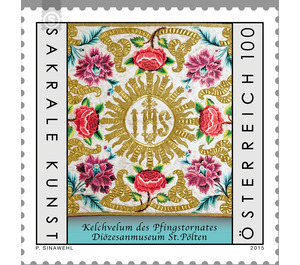art - Austria / II. Republic of Austria 2015 - 100 Euro Cent
Theme: Art & Culture
| Country | Austria / II. Republic of Austria |
| Issue Date | 2015 |
| Face Value | 100.00 |
| Edition Issued | 200,000 |
| Printing Type | Combination printing, offset stitch (Etch-Art by OeSD) |
| Stamp Type | Commemorative |
| Item Type | Stamp |
| Chronological Issue Number | 2557 |
| Chronological Chapter | OOS-OE2 |
| SID | 791879 |
| In 63 Wishlists | |
Under a calyx level one understands a usually artistically manufactured cloth, which covers in the Roman catholic fair as well as in the Lutheran communion service the goblet for the consecrated hosts or the measuring wine. The sepia presented on the new special stamp is part of a whole series of liturgical textiles, which together form the "Pentecostal" called convolute. These include, among other things Antependien, so curtains for the substructure of the altar, stoles and Pluviale (liturgical vestments). These gorgeous velvet velvet fabrics are embellished with gold, silver and petit point embroidery and lined with taffeta. The chalice level of the "Whitsun" is made of silver brocade, symmetrically designed and richly decorated with gold. Eight flowers of colorful silk are combined with a wide gold band: red roses decorate the side centers, purple carnations decorate the corners. In the middle is the golden lettering "IHS". The precious embroidery is made in flat stitch, and it is believed that they were designed by Empress Elisabeth Christine, the mother of Maria Theresa, artfully. What is certain, however, is that the goblet has been embroidered with the utmost precision and precision work, and that the composition of the motifs is highly considered. - Today you can visit the "Pentecost", whose name refers to its red color because of this high feast in the liturgical year, in the Diocesan Museum of St. Pölten, where it is on loan to the "Congregation of Jesus" permanently issued.


